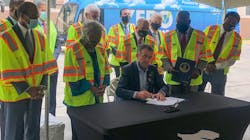Hampton Roads Transit wins dedicated funding; expanded express bus service in development
Hampton Roads Transit (HRT) reached an historic milestone in September when it hosted a ceremonial bill-signing event at its Norfolk, Va., campus that will forever change the way the agency plans and funds its regional bus service.
Legislation that allows HRT to receive dedicated regional funding means it will proceed with ambitious plans to launch a 13-route Regional Backbone bus service linking the six cities it serves with 15-minute frequency and enhanced customer amenities.
Planning for the service has been underway for months and now with the dedicated funding in place the agency is doubling down on the complex task of execution. Deployment of the enhanced bus service will take place in phases.
“I’m so proud of all the successes we’ve achieved together thus far,” said William Harrell, HRT’s President and CEO during the ceremony.
The bill signing took place with Virginia Gov. Ralph Northam ceremoniously endorsing Senate bill 1038 and House bill 1726 – they were actually signed in July - that put in place a sustained mix of funding for public bus transportation that transit riders across the region have long demanded.
Also present were State Sen. Louise Lucas (D-District 18), who sponsored the senate bill, and State Delegate Alex Askew (D-District 85), who sponsored the house version, Secretary of Natural Resources Matthew Strickler and Director of the Department of Rail and Public Transportation (DRPT) Jennifer Mitchell.
The funding is noteworthy because it marks a departure from how HRT has been traditionally funded. Each year, the agency negotiates service contracts with the cities it serves. Some request significant service, others less so. HRT must then cobble it all together for the region.
The result is a span of service that is patchwork with many headways falling into an hour. This limits the usefulness of transit in a metropolitan area with more than a million residents. HRT currently only offers six routes with 15-minute service frequency at peak hours.
The dedicated funding means that HRT can plan and operate the Regional Backbone routes outside of the municipal budget process and the politics that often entangle it. The core service, including Virginia’s only light rail and a ferry service across the Elizabeth River, will continue to be funded by local municipalities and grant funds.
The dedicated funding could eventually yield about $30 million annually for the agency which currently has an annual operating budget of about $100 million. Both operating and capital expenses are eligible under the funding guidelines as are expansion projects and those falling under the State of Good Repair conditions.
The funding also will help HRT enhance some passenger transfer facilities that serve as anchors for the regional network, but which are tired and outdated. Under the old funding arrangement, replacing them would take years.
To provide expanded service, HRT anticipates buying 48 new diesel buses (including spares) and boost its operator compliment by 290 drivers plus an appropriate number of service technicians. A recruiting campaign is gearing up now.
The first enhanced service will be deployed in Hampton and Newport News – two Virginia peninsula cities that HRT serves. Newport News is where the massive Huntington Ingalls Industries shipyard is located and where the nation’s aircraft carriers and submarines are built. Transit service is popular there because parking is very limited and where new ship-building contracts have been awarded, driving the need to hire more staff.
Next in line for expanded service will be cities on the region’s Southside – Norfolk, Portsmouth, Virginia Beach and Chesapeake.
With a surge of new people and equipment, HRT also plans to create a new bus operating division that will allow it to replace a 50-year-old, antiquated facility that will serve as a second bus operating division for southside cities. That new division also will allow HRT to store and maintain an expanded southside fleet.
The research that lead to the push for legislative relief indicates why HRT and its regional partners believe the investment is a wise one.
Under HRT’s existing profile, studies have shown that reaches about 181,000 citizens and that it serves roughly 137,500 jobs. When the new expanded regional service is in full swing, HRT anticipates reaching an estimated 487,000 citizens – a 169 percent increase – and upwards of 312,000 jobs – a 127 percent increase.
With more frequent service reaching more people, HRT is expecting an increase in boardings. HRT also is moving aggressively to implement “Real Time” bus technology allowing customers to use their smart phones to take the guess work out of when their bus will arrive and a mobile ticket payment system to make commuting as seamless as possible.
The agency also plans to install passenger information displays to help customers know where buses are and when to expect them. Hundreds of new shelters are planned.
The ceremonial signing also carried with it another milestone: the arrival of Virginia’s first all-electric buses.
Manufactured by Proterra in Greenville, S.C., six buses will be assigned to the route operating along Virginia Beach Boulevard between the Downtown Norfolk Transit Center and the Virginia Beach Oceanfront, one of Virginia’s busiest local bus routes.
The battery buses are in an evaluation stage now and are expected to be deployed to revenue service sometime between Election Day and Thanksgiving.
-----------------------------------------
Tom Holden works in the Marketing and Communications Department of Hampton Roads Transit. He is the media liaison, the Freedom of Information Act officer, a writer on the agency’s monthly newsletter, and often serves as spokesman when more senior executives are not available.
About the Author

Tom Holden
Tom Holden works in the Marketing and Communications Department of Hampton Roads Transit. He is the media liaison, the Freedom of Information Act officer, a writer on the agency’s monthly newsletter and often serves as spokesman when more senior executives are not available.


